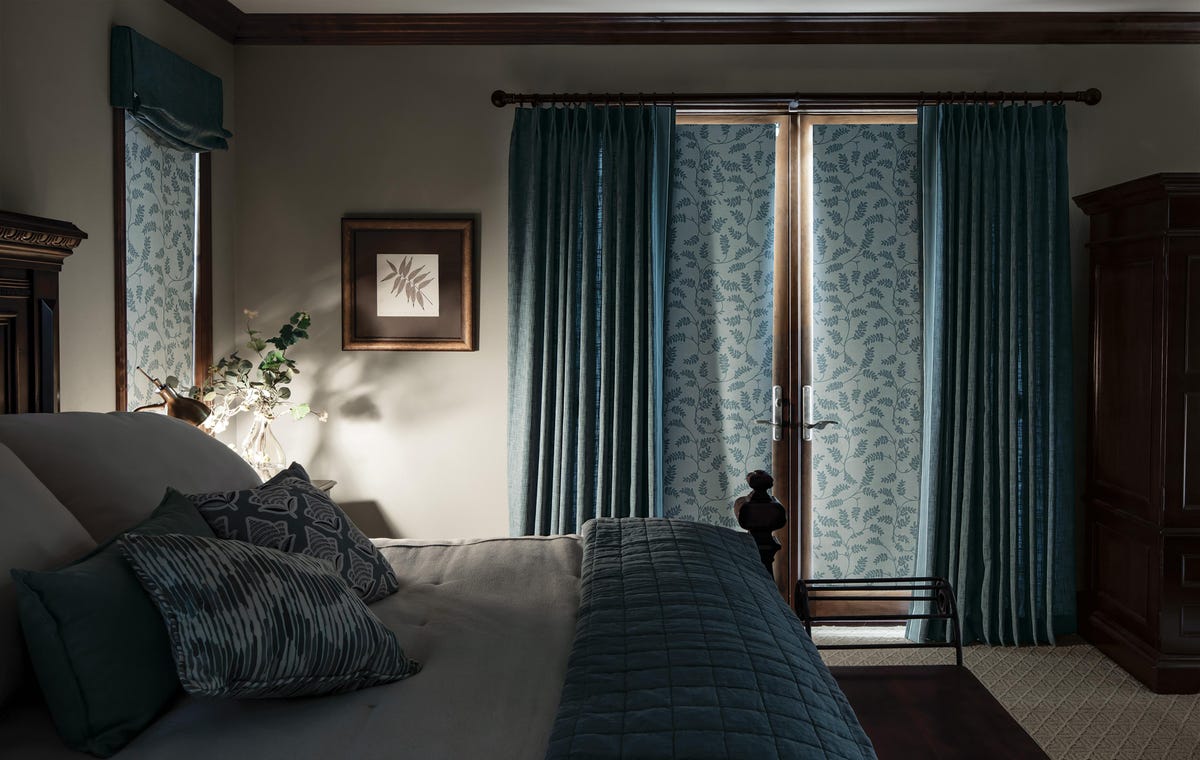
Blackout window coverings can help TBI patients avoid or reduce migraine suffering.
Thursday, November 11 is Veteran’s Day in the United States, when we honor those who have served in our nation’s armed services. According to the Veteran’s Administration, more than 185,000 of the vets who have received care in one of their facilities have been diagnosed with a traumatic brain injury (TBI), and between 11% and 20% of Iraq and Afghanistan war vets suffer from post-traumatic stress disorder (PTSD). The two often coexist, since so many brain injuries are sustained in traumatic experiences. These wounds of war are often hidden, but impact the men and women who have sacrificed for our country as powerfully as those injuries that are visible.
Fortunately, there are treatments available for both TBIs and PTSD, and some involve adding wellness design features to the vet’s home to help manage the physical and psychological challenges. These make it safer, more functional and comfortable to use during and after recovery.
Jennifer Bertrand has worked on more than a dozen homes for wounded warriors, she shares, and has implemented wellness design practices and elements in each project to help these veterans adjust to life with injuries. “For the last four years, I have been the designer on a show called Military Makeover with Montel Williams,” the Kansas City area design pro notes. Every one of those vets had to cope with psychological as well as physical issues, she adds, including patients with TBIs and PTSD.
Traumatic Brain Injury Defined
Neurologist Russell Gore, MD heads up the SHARE Military Initiative at Atlanta-based Shepherd Center. He describes TBIs as “any injury resulting in a change in brain function.” Injuries can be caused by a direct head blow, skull fracture, object penetration or the brain jolting within the skull without an external impact. Conditions related to these, or any combination of them, (as sometimes happens in combat settings), can have short or long-term duration.
“A change in brain function can include impairments in movement, weakness, memory problems, confusion, dizziness, imbalance and vision problems,” Gore explains. Vets suffering from blast injuries resulting in TBIs, even in the mild range (mTBIs), may have longer-term effects, he adds.
MORE FOR YOU
Signature Issue
These mTBIs caused by blast injuries are considered the signature issue of the Iraq and Afghanistan Wars. Improvised explosive devices, heavy munitions firing and training accidents are all common sources, according to Frontiers in Neurology. Though the injuries may be considered mild in physical terms, there are other, serious ramifications. “It has been shown that depression and PTSD are major components of the psychological changes that accompany mTBI and, more recently, that suicide is associated,” the medical journal article reveals.
Heading Home
After being treated at the Shepherd Center or another facility, a patient typically moves back home. “Just as each brain injury is unique, so are the homes that our patients discharge to,” comments occupational therapist Nicole Prevost, Gore’s colleague at Shepherd. “Each one presents different challenges. A once-familiar environment, a person’s home post-injury can turn into a dangerous obstacle course.”
Accessibility will be an issue for new wheelchair users – impacted by both TBI and limb damage – and their caregivers. “The tub that used to be used to relieve stress and relax may now be the barrier that will prevent people from being able to take a shower,” Prevost notes. “The cozy details of a home, such as a throw rug or ottoman, are now hurdles that may need to be removed.”
Home Challenges
In addition to potential mobility issues from both balance-impacting TBIs and other physical injuries creating the need for accessibility adaptations, there are psychological adaptations that may be required. “Due to the TBI patient’s poor insight or limited decision-making skill, items such as knives, car keys and guns may need to be locked away,” Prevost adds. Biometric locks for knife and key storage, as well as biometric safe boxes for guns, can be helpful in protecting the TBI patient during his or her recovery.
Home Supports
Wellness technology that helps patients and caregivers communicate across rooms, like smart speakers, and adjusts lighting, like smart window coverings and voice or app-based controls, can be helpful to the TBI patient. “A very high percentage of the veterans I work with have headaches or migraines,” shares Nan Verbel, TBI/PTSD clinical specialist at Durham, North Carolina’s VA Medical Center. “They use dimmer lighting in their homes and may use blackout curtains for this as well as to help deal with their problems with sleep.” Bertrand uses dimmers in her projects too, she says, as well as LEDs with adjustable light temperature.
Memory challenges are also prevalent, Verbel comments. In addition to personal technology, strategic placement of calendars or dry erase boards in the kitchen, bedroom or home office can be helpful, the occupational therapist suggests. Bertrand observes: “I have found that if one’s home is in order, it helps the mind be in order. I sometimes add organizers that allow for home flow. These can be drawer inserts or pull out pantries, or just in how the space is rearranged.”
Comfort Supports
Bertrand describes the process of creating a supportive home for one recent combat veteran whose home she worked on, in addition to making the kitchen accessible for him to cook in with his family: “The first step we took was to declutter the home to give this veteran and his family a calming space.”
Spaces that calm and nurture are key, Bertrand notes. “It is very important for veterans facing depression and mood swings brought on by TBIs and other injuries to not isolate themselves. Find areas of the home that can house newfound activities or hobbies, but still allow them to happen in the heart of the home,” the designer suggests.
Other calming features can be fountains, koi ponds, water walls, gardens and nature-inspired artwork. These all fall into the category of biophilia, which has been shown to help in stress reduction and recovery from injuries and illness.
Safety Supports
Smart home technology can contribute to a feeling of safety in the home, which can be beneficial for vets with PTSD. These patients “feel most comfortable staying inside their homes and do not go places due to anxiety and hyper-vigilance,” observes Verbel. A connected security system can help them with these anxieties.
Sometimes it’s more basic, Bertrand shares: “A lot of our veterans with PTSD fought night terrors and had major issues in sleeping,” the designer recalls. “I found that by making sure there were dual temperature controls in the bedroom, both the veteran and their partner could be comfortable. It can be as simple as mounting a wall fan that only points on one person, having a dual adjustable mattress, having two separate top quilts, or in some cases when our veteran simply could not sleep, creating a separate environment where they could go to not affect their partner’s sleep.”
Another safety support many veterans with PTSD bring home is a service animal. “I found that when we made over the homes the animals’ space was just as important,” Bertrand says.
Expressing Gratitude
Different veterans cope in different ways, the designer adds, and urges those who appreciate their service to “put your heart into action. Find a veteran neighbor and do something amazing for them. Organize their pantry, find their military memorabilia and put some of it on display, freshen a paint color for them or,” as she fondly recalls Marine and Navy veteran Montel Williams saying, “don’t just say thank you for serving, show thank you for serving.”




